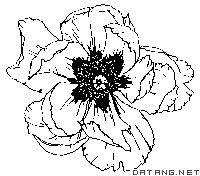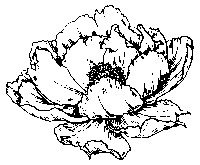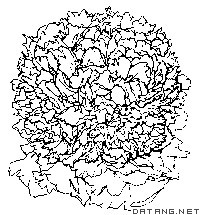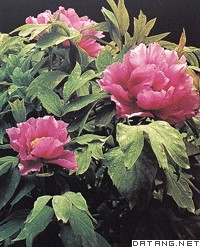1) descriptions of peony


牡丹记叙
2) peony
[英]['pi:əni] [美]['piənɪ]


牡丹
1.
Analysis of the application of the form beauty of peony pattern in the folk clothes;


牡丹纹样在民间服饰中的形式美
2.
Study on method of measuring potassium content in peony leaf by distilled water at room tempreture flame spectrometry;
水浸提制备待测液火焰光度法测定牡丹叶中钾含量的方法研究
3.
Study on Biological Characters of the Pathogens of Root Rot Disease and Its Control from Peony;
垫江牡丹根腐病病原菌的生物学特性及其防治
3) Tree Peony


牡丹
1.
Effects of browning antagonists on antibrowning,growth and multiplication of tissue culture of tree peony;
防褐剂对牡丹组培褐化发生、组培苗生长和增殖的作用
2.
Phylogenetic relationship of dwarf tree peony cultivars by AFLP analysis.;


牡丹矮化品种亲缘关系的AFLP分析
3.
Control of tree peony root rot using 6 species of biocontrol fungi and bacteria;


6种生防真菌、细菌防治牡丹根腐病的研究
4) tree-peony


牡丹
1.
AM fungi diversity in the main tree-peony cultivation areas in China;


我国洛阳与菏泽牡丹主栽园区AM真菌多样性研究
2.
Natural Infection Percentage of Arbuscular Mycorrhizal in Chinese Tree-peony;


牡丹AM菌根菌自然侵染率的调查
3.
After investigated all the main tree-peony production areas,the authors found many problems on Chinese tree-peony,such as resources protection,breed-ing,variety structure,technologies of cultiva-tion and conservation,etc.
我国牡丹在发展过程中存在资源流失、市场混乱、产品结构不合理、栽培管理技术落后、基础和应用研究薄弱等多方面的问题。
5) Paeonia suffruticosa Andr


牡丹
1.
Comparison of Photosynthetic Characteristics Between Potted and Field Paeonia suffruticosa Andr.;
盆栽和地栽牡丹光合特性的比较
2.
Influences of Cold-storage Method on the Growth and Development of "Ming Xing" Paeonia suffruticosa Andr;
冷藏方式对“明星”牡丹生长发育的影响
3.
Anatomical Observation on Paeonia suffruticosa Andr.and Paeonia lactiflora Pall.Based on Phytomorphology of Stem and Leaf;
芍药和牡丹部分品种茎叶器官的解剖学观察比较
6) Paeonia suffruticosa


牡丹
1.
Effects of Short-Term High Temperature on Photosynthesis and Related Physiological Indices in the Leaves of Paeonia suffruticosa;
短期高温对牡丹叶片光合作用及相关生理指标的影响
2.
Study on DNA Extraction Methods of Paeonia suffruticosa and Paeonia lactiflora Pall;


牡丹·芍药DNA提取方法研究
补充资料:牡丹
| 牡丹 Paeonia suffruticosa;peony 毛茛科芍药属落叶灌木。原产中国的传统名花。又称木芍药、洛阳花、鹿韭等。花大而多变,色彩艳丽,富丽堂皇,被誉为花中之王。
秦汉时期《神农本草经》中已有以牡丹根皮入药的记载。南北朝时始栽供观赏;至隋已成奇花。唐时牡丹为皇宫珍品,开元年间长安栽培很盛,且育出许多品种。北宋时牡丹栽培中心自长安移至洛阳,号称"洛阳牡丹甲天下"。明代栽培中心又自洛阳移至安徽亳州。约在明嘉庆、万历年间山东曹州菏泽牡丹兴起,至清代即取代亳州而在全国名列前茅。牡丹约于8世纪时传至日本,后育成许多品种。1787 年传入英国。此后辗转流传,成为世界性名花。 牡丹具深根性肉质根。株高0.5~2米。枝多而粗壮。小叶阔卵形至卵状长圆形,先端2~5裂,背面具白粉。花单生枝顶,花瓣5~10,雄蕊多数 。原种花红紫色,栽培品种则多种颜色,并形成多种花型。春末开花。蓇葖果。种子球形,黑色,有光泽 。牡丹品种繁多 , 迄今尚无统一的分类方法。一般可按花色分为白、黄、粉、红、紫、墨(暗紫色)、雪青(莲青)、绿色等品种;按花期分为早花、 中花、 晚花品种。中国古时还按花型分为多叶与千叶两类。近代中国的分类系统依据雄蕊、雌蕊的瓣化将牡丹分为3类12型( 见图 )。主要分布在中国西北部的甘肃、陕西、山西、四川、河南等山区。性喜阳光充足 、干燥温凉 、夏无高温 ,冬不甚寒之地。要求排水良好、中性至微碱性(pH7.0~7.5)的深厚壤土或富含腐殖质的粘质壤土 。分株 、压条 、嫁接或播种繁殖均可。主要病害有叶斑病、紫纹羽病等。牡丹雍容华贵,花大叶茂,适于庭院种植或花坛布置,可丛栽,也可孤植或盆栽。如成片群配以山石道路 ,则可成为牡丹园 。根皮可加工成中药“丹皮”,有镇静作用。
|
说明:补充资料仅用于学习参考,请勿用于其它任何用途。
参考词条



